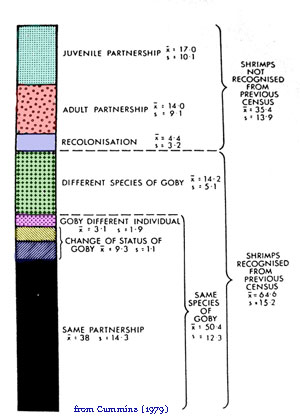





 Population
Dynamics
Population
Dynamics
The study of population dynamics and population ecology for the shrimp-goby relationship is exceedingly difficult, is made possible by the fact that tagged individuals almost invariably will be found again in the same general region if not the same hole, on future assessments. The real key is to be able to observe a population over time and be able to recognize individuals, or at least trends in a population that would give clues as to the activity of individuals in the population over time.
One of the best examples of a well-documented population studies comes from the PhD thesis work of Cummins (1979) on One Tree Reef, Australia. The shrimp and gobies studied in this area live in a climate that tropical and thus not seasonal to any great degree. As a result there was no seasonal variation in population dynamics as has been found in places like Japan where there is a marked seasonality (Yanagisawa 1984). Cummins (1979) examined the stability of partnerships in the bay to answer the question if shrimp and goby are bound for life. The figure above shows his results. As it turns out, only about 70 percent of the shrimp that he was able to recognize from the first marking ended up with the same goby as before. The others had paired with either different gobies of the same species or other species altogether. There were also several shrimp that had not been recognized in the first treatment that were paired with gobies. Of these, about half were juvenile pairings indicating that they probably were overlooked in the first observation because of their small size.
The question then is why might these gobies move from hole to hole. Cummins offered a few explanations. First the burrows could be displaced as a bigger goby moved in. Several gobies may leave their own burrow to look for a mate, thus freeing burrows to be colonized by other individuals. Finally, death caused by predation or disease may have resulted in displacement.
Another important question in population ecology deals with the life
histories of the individuals. How long is it before individuals can reproduce
and what is their life expectancy? Yanagisawa (1982, 1984) attempted to
deal with such a question, with his work on Alpheus bellulus and Amblyeleotris
japonica in southern Japan. He found that in this species, which is highly
seasonal, with new recruits of both individuals settling in September
to October, the adult population consisted of 1 year olds and 2 year olds.
Both shrimp and goby reach reproductive age in a year and start breeding.
Mortality is high for new recruits, with 60% mortality in 3 months and
80% mortality in a year.